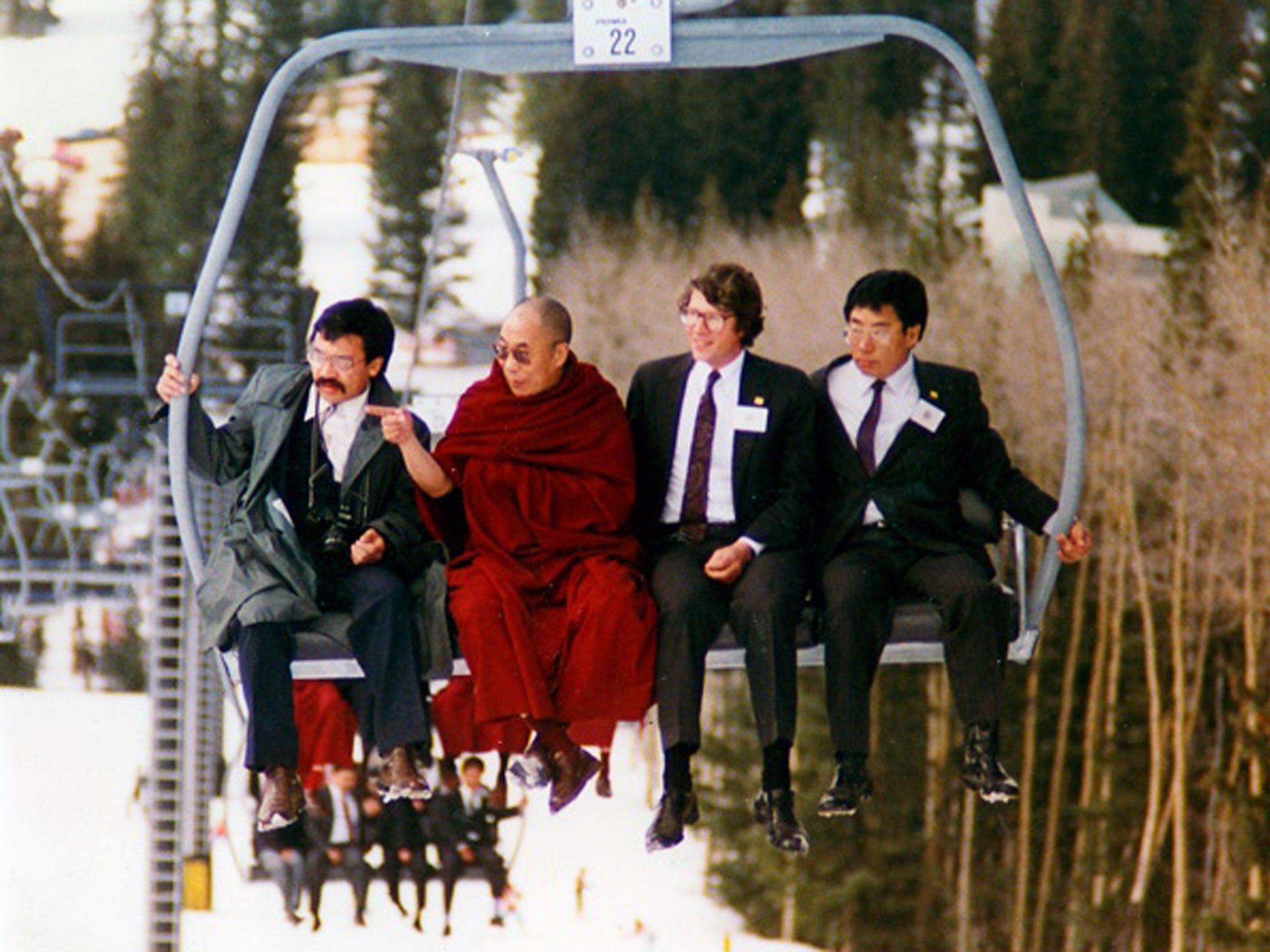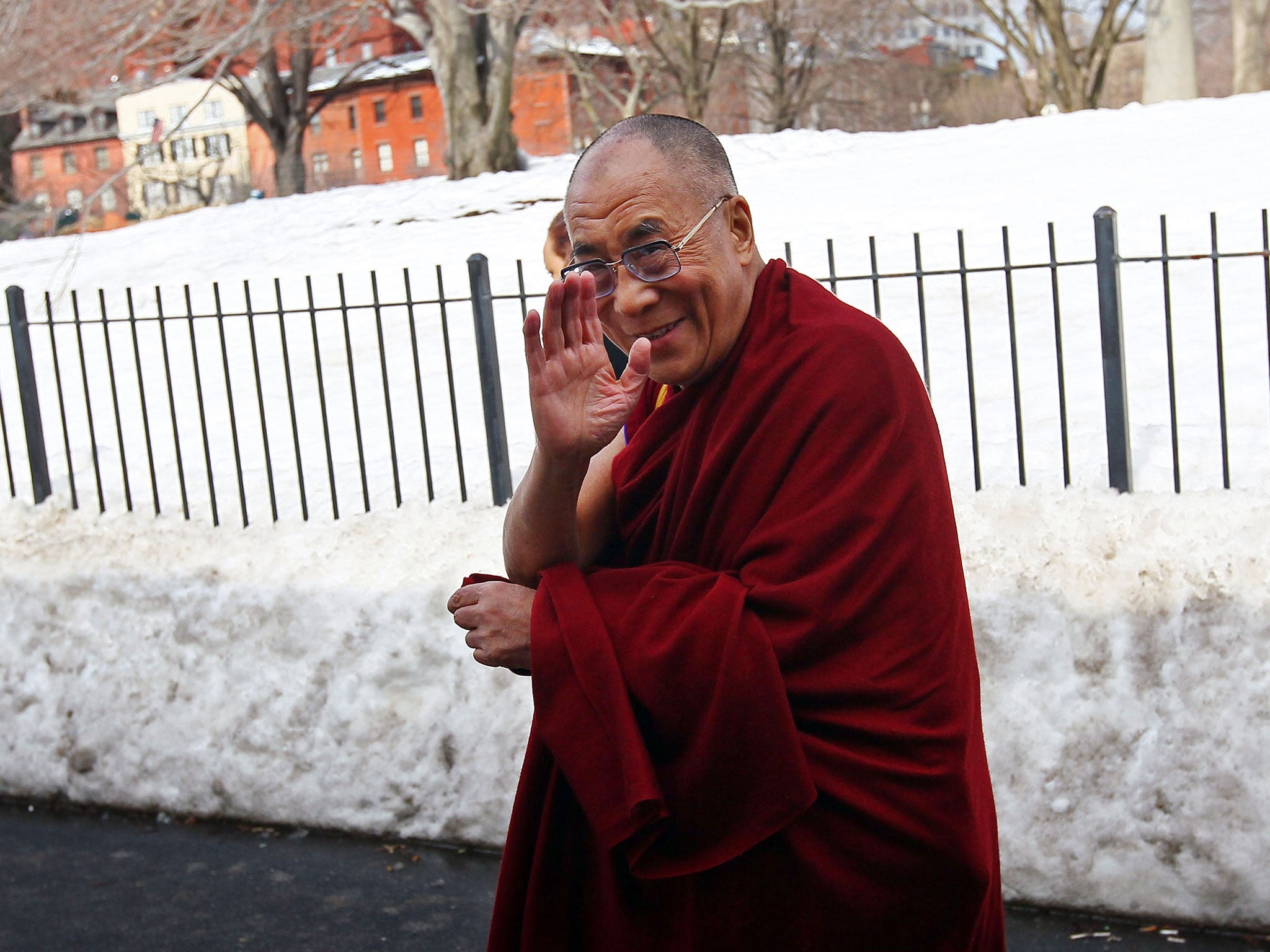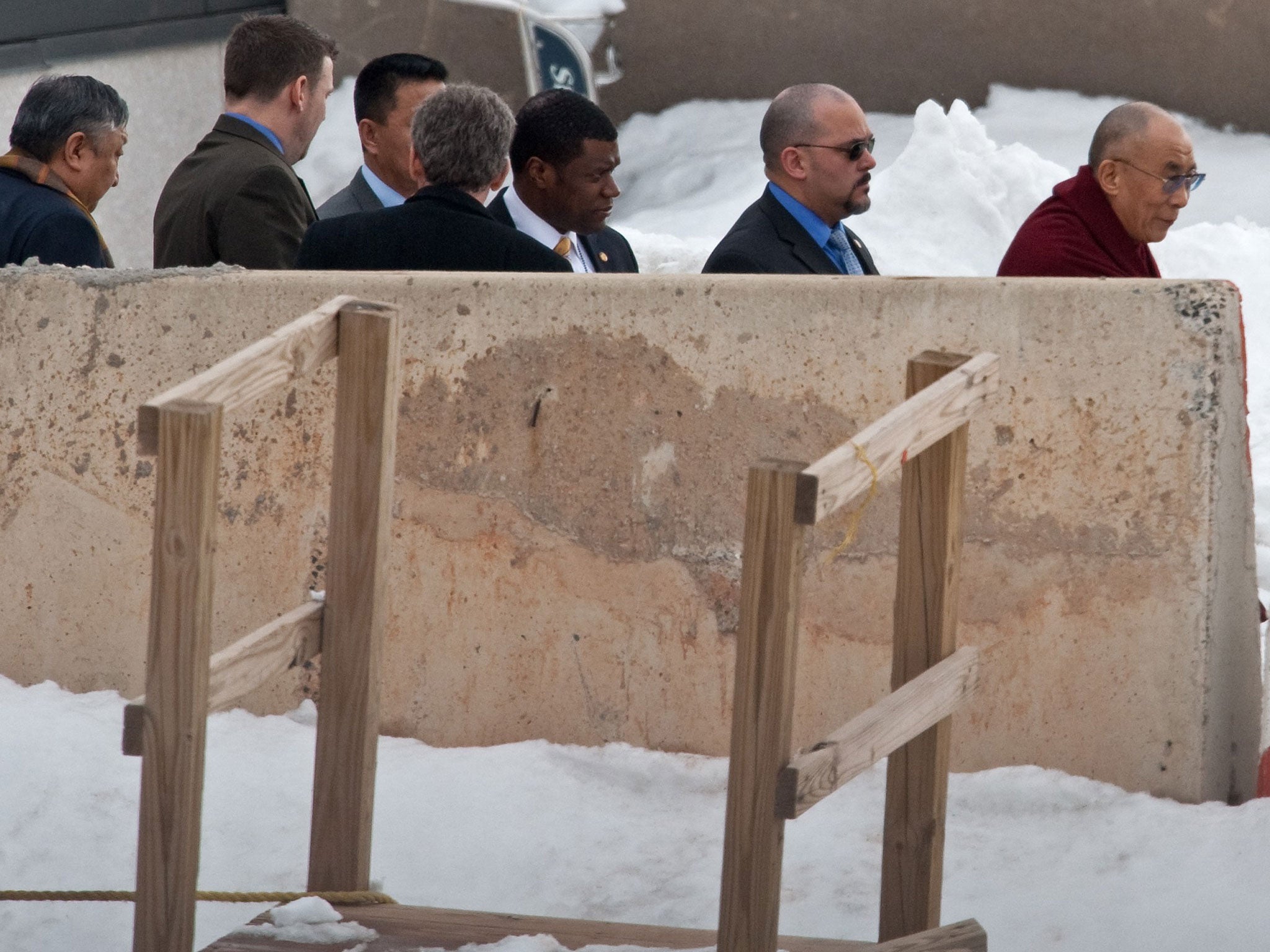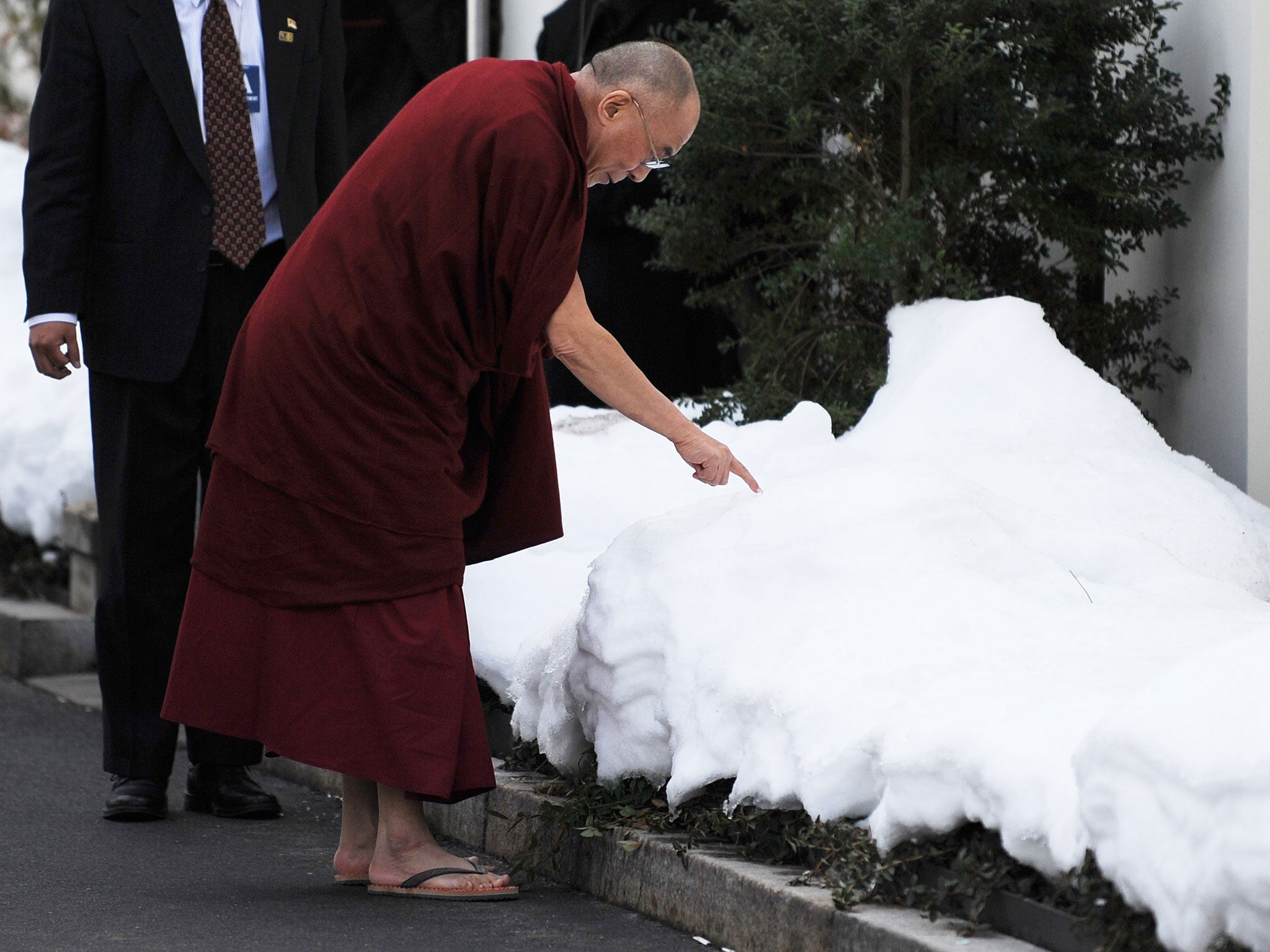The day the Dalai Lama hit the slopes in Santa Fe
When the Tibetan spiritual leader paid a visit to Santa Fe, Douglas Preston was drafted in as his press secretary. So he was there when the holy man revealed a surprising new passion

Your support helps us to tell the story
From reproductive rights to climate change to Big Tech, The Independent is on the ground when the story is developing. Whether it's investigating the financials of Elon Musk's pro-Trump PAC or producing our latest documentary, 'The A Word', which shines a light on the American women fighting for reproductive rights, we know how important it is to parse out the facts from the messaging.
At such a critical moment in US history, we need reporters on the ground. Your donation allows us to keep sending journalists to speak to both sides of the story.
The Independent is trusted by Americans across the entire political spectrum. And unlike many other quality news outlets, we choose not to lock Americans out of our reporting and analysis with paywalls. We believe quality journalism should be available to everyone, paid for by those who can afford it.
Your support makes all the difference.In the mid 1980s, I was living in Santa Fe, New Mexico, making a shabby living writing magazine articles, when a peculiar assignment came my way. I had become friendly with a group of Tibetan exiles who lived in a compound on Canyon Road, where they ran a business selling Tibetan rugs, jewellery, and religious items. The Tibetans had settled in Santa Fe because its mountains, adobe buildings, and high-altitude environment reminded them of home.
The founder of the Tibetan community was a man named Paljor Thondup. Thondup had escaped the Chinese invasion of Tibet as a child, crossing the Himalayas with his family in an epic, multi-year journey by yak and horseback.
He made it to Nepal and, from there, to India, where he enrolled in a school in the south-eastern city of Pondicherry with other Tibetan refugees. One day, the Dalai Lama visited his class. Many years later, in Dharamsala, India, Thondup talked his way into a private audience with the Dalai Lama, who told Thondup that he had never forgotten the bright teenager at the back of the Pondicherry classroom, waving his hand and answering every question, while the other students sat dumbstruck with awe. They established a connection. And Thondup eventually made his way to Santa Fe.
The Dalai Lama received the Nobel Peace Prize in 1989. Thondup, who had heard that he was planning a tour of the United States, invited him to visit Santa Fe. The Dalai Lama accepted and said he would be happy to come for a week. At the time, he wasn’t the international celebrity he is today. He travelled with only a half-dozen monks, most of whom spoke no English. He had no handlers, advance men, interpreters, press people, or travel co-ordinators. Nor did he have any money. As the date of the visit approached, Thondup went into a panic. He had no money to pay for the visit and no idea how to organise it. He called the only person he knew in government, a young man named James Rutherford, who ran the governor’s art gallery in the state capitol building. Rutherford was not exactly a power broker in the state of New Mexico, but he had a rare gift for organisation. He undertook to arrange the Dalai Lama’s visit.
Rutherford began making phone calls. He borrowed a stretch limousine from a wealthy art dealer, and he asked his brother, Rusty, to drive it. He persuaded the proprietors of Rancho Encantado, a luxury resort outside Santa Fe, to provide the Dalai Lama and his monks with free food and lodging. He called the state police and arranged for a security detail.
Among the many phone calls that Rutherford made, one was to me. He asked me to act as the Dalai Lama’s press secretary. I explained to Rutherford that he had the wrong person, that I had no experience in that line, and that it would surely be a disaster. Rutherford said that he didn’t have time to argue. The Dalai Lama, he explained, was a person who would stop and talk to anyone who asked him a question. He treated all people the same, from the president of the United States to a bum on the street, giving every person his full time and attention. Someone had to manage the press and keep the Dalai Lama from being buttonholed. And that person was going to be me.
I desperately needed the money, and so I agreed. As Rutherford was about to ring off, I asked how much I’d be paid. He was incredulous and told me he was saddened by my avarice. How could I even think about being paid for the privilege of spending a week with His Holiness? On the contrary, the volunteers were expected to give, not get. He had the pledge sheet right in front of him; how much could he put me down for? I pledged $50.
The Dalai Lama arrived in Santa Fe on 1 April, 1991. I was by his side every day from 6am until late in the evening. Travelling with him was an adventure. He was cheerful and full of enthusiasm – making quips, laughing, asking questions, rubbing his shaved head, and joking about his bad English. He did, in fact, stop and talk to anyone, no matter how many people were trying to rush him to his next appointment. When he spoke to you, it was as if he shut out the rest of the world to focus his entire sympathy, attention, care and interest on you.

He rose every morning at 3.30 and meditated for several hours. While he normally went to bed early, in Santa Fe he had to attend dinners most evenings until late. As a result, every day after lunch we took him back to Rancho Encantado for a nap.
The press converged from several states to cover the story, which was far bigger than we anticipated. There were scores of reporters and television crews. I had no idea what I was doing. During the course of the week, many people were angry with me and one fellow called me a “f***ing idiot”. But I muddled through. The Dalai Lama met politicians, film stars, New Age gurus, billionaires, and Pueblo Indian leaders. On the penultimate day of his visit, the Dalai Lama had lunch with the senators from New Mexico and the state’s governor. During the luncheon, someone mentioned that Santa Fe had a ski area. The Dalai Lama seized on this news and began asking questions about skiing – how it was done, if it was difficult, who did it, how fast they went, how did they keep from falling down.
After lunch, the press corps dispersed. Nothing usually happened when the Dalai Lama and his monks retired to Rancho Encantado for their afternoon nap. But this time, something did happen. Halfway to the hotel, the Dalai Lama’s limo pulled to the side of the road. I was following behind the limo in Thondup’s car, and so we pulled over, too. The Dalai Lama got out of the back of the limo and into the front seat. We could see him speaking animatedly with Rusty, the driver. A moment later, Rusty got out of the limo and came over to us with a worried expression on his face. He leant in the window.
“The Dalai Lama says he isn’t tired and wants to go into the mountains to see skiing. What should I do?”
“If the Dalai Lama wants to go to the ski basin,” Rutherford said, “we go to the ski basin.”
The limo made a U-turn, and we all drove back through town and headed into the mountains. Forty minutes later, we found ourselves at the ski basin. It was the tail end of the ski season but the mountain was still open. We pulled up below the main lodge. The monks piled out of the limo.
“Wait here while I get somebody,” Rutherford said. He disappeared in the direction of the lodge and returned five minutes later with Benny Abruzzo, whose family owned the ski area. Abruzzo was astonished to find the Dalai Lama and his monks milling about in the snow, dressed only in their robes. It was a splendid April day, perfect for spring skiing – the temperature about 15C, the slopes crowded, the snow of the kind that skiers call “mashed potatoes”. The Dalai Lama and his monks looked around with keen interest at the activity, the humming lifts, the skiers coming and going, and the slopes rising into blue sky.
“Can we go up mountain?” the Dalai Lama asked Rutherford.
Rutherford turned to Abruzzo. “The Dalai Lama wants to go up the mountain.”
“You mean, ride the lift? Dressed like that?”
“Well, can he do it?”
“I suppose so. Just him, or...?” Abruzzo nodded at the other monks.
“Everyone,” Rutherford said. “Let’s all go to the top.”
Abruzzo spoke to the operator of the quad chair. Then he shooed back the line of skiers to make way for us, and opened the ropes. A hundred skiers stared in disbelief as the four monks, in a tight group, gripping each other’s arms and, taking tiny steps, came forward. Underneath their maroon and saffron robes, the Dalai Lama and his monks all wore the same footwear: Oxford wingtip shoes. Wingtips are terrible in the snow. The monks were slipping and sliding, and I was sure that one would fall and bring down the rest.
We made it to the lift without spilling, and the operator stopped the machine, one row of chairs at a time, to allow everyone to sit down in groups of four. I ended up sitting next to the Dalai Lama, with Thondup to my left. The Dalai Lama turned to me. “When I come to your town,” he said, “I see big mountains all around. Beautiful mountains. And so all week I want to go to mountains.” The Dalai Lama had a vigorous way of speaking, in which he emphasised certain words. “And I hear much about this sport, skiing. I never see skiing before.”
“You’ll see skiing right below us as we ride up,” I said.
“Good! Good!”

We started up the mountain. The chairlift was old and there were no safety bars that could be lowered for protection, but this didn’t seem to bother the Dalai Lama, who spoke animatedly about everything he saw on the slopes. As he pointed and leaned forward into space, Thondup, who was gripping the arm of the chair with whitened knuckles, kept admonishing him in Tibetan. Later, he told me that he was begging His Holiness to please sit back, hold the seat, and not lean out so much.
“How fast they go!” the Dalai Lama said. “And children skiing! Look at little boy!”
We were looking down on the bunny slope and the skiers weren’t moving fast at all. Just then, an expert skier entered from a higher slope, whipping along. The Dalai Lama saw him and said, “Look – too fast! He going to hit post!” He cupped his hands, shouting down to the oblivious skier, “Look out for post!” He waved frantically. “Look out for post!”
The skier, who had no idea that the 14th incarnation of the Bodhisattva of Compassion was crying out to save his life, made a crisp little check as he approached the pylon, altering his line, and continued expertly down the hill. With an expostulation of wonder, the Dalai Lama sat back and clasped his hands together. “You see? Ah! Ah! This skiing is wonderful sport!”
We approached the top of the mountain. Abruzzo had organised the operation so that each quad chair stopped to unload its occupants. The monks and the Dalai Lama managed to get off the chairlift and make their way across the mushy snow in a group, shuffling cautiously.
“Look at view!” the Dalai Lama cried, heading toward the back boundary fence of the ski area, behind the lift, where the mountains dropped off. He halted at the fence and stared southward. The Santa Fe ski basin, situated on the southernmost peak in the Sangre de Cristo mountain range, is one of the highest ski areas in North America. The snow and fir trees and blue ridges fell away to a vast, vermilion desert 5,000ft below, which stretched to a distant horizon.
As we stood, the Dalai Lama spoke enthusiastically about the view, the mountains, the snow and the desert. After a while, he lapsed into silence and then, in a voice tinged with sadness, he said, “This look like Tibet.”
The monks admired the view a while longer, and then the Dalai Lama pointed to the opposite side of the area, which commanded a view of 12,000ft peaks. “Come, another view over here!” And they set off, in a compact group, moving swiftly across the snow.
“Wait!” someone shouted. “Don’t walk in front of the lift!”
But it was too late. I could see the operator, caught off guard, scrambling to stop the lift, but he didn’t get to the button in time. Just then, four teenage girls came off the quad chair and were skiing down the ramp straight at the group. A chorus of shrieks went up, of the piercing kind that only teenage girls can produce, and they ploughed into the Dalai Lama and his monks, knocking them down like so many red and yellow bowling pins. Girls and monks all collapsed into a tangle of arms, legs, skis, poles, and wingtip shoes. We rushed over, terrified that the Dalai Lama was injured. Our worst fears seemed realised when we saw him sprawled on the snow, his face distorted, his mouth open, producing an alarming sound. Was his back broken? Should we try to move him? And then we realised that he was not injured after all, but was helpless with laughter.

“At ski area, you keep eye open always!” he said.
We untangled the monks and the girls and steered the Dalai Lama away from the ramp, to gaze safely over the snowy mountains of New Mexico.
He turned to me. “You know, in Tibet we have big mountains.” He paused. “I think, if Tibet be free, we have good skiing!”
We rode the lift down and repaired to the lodge for cookies and hot chocolate. The Dalai Lama was exhilarated from his visit to the top of the mountain. He questioned Abruzzo minutely about the sport of skiing and was astonished to hear that even one-legged people could do it.
The Dalai Lama turned to Thondup. “Your children, they ski too?”
Thondup assured him that they did.
“Even Tibetan children ski!” he said, clapping his hands together and laughing delightedly. “Yes, this wonderful sport!”
As we finished, a young waitress with tangled, dirty-blonde hair and a beaded headband began clearing our table. She stopped to listen to the conversation and finally sat down, abandoning her work. After a while, when there was a pause, she spoke to the Dalai Lama. “You didn’t like your cookie?”
“Not hungry, thank you.”
“Can I, um, ask a question?”
“Please.”
She spoke with complete seriousness. “What is the meaning of life?”
In my entire week with the Dalai Lama, every conceivable question had been asked – except this one. People had been afraid to ask the one – the really big – question. There was a brief, stunned silence at the table.
The Dalai Lama answered immediately. “The meaning of life is happiness.” He raised his finger, leaning forward, focusing on her as if she were the only person in the world. “Hard question is not, ‘What is meaning of life?’ That is easy question to answer! No, hard question is what make happiness. Money? Big house? Accomplishment? Friends? Or...” He paused. “Compassion and good heart? This is question all human beings must try to answer: What make true happiness?” He gave this last question a peculiar emphasis and then fell silent, gazing at her with a smile.
“Thank you,” she said, “thank you.” She got up and finished stacking the dirty dishes and cups, and took them away.
Douglas Preston is the New York Times No 1 bestselling author of ‘The Monster of Florence: A True Story’, currently being made into a film starring George Clooney.
This article first appeared on slate.com
Join our commenting forum
Join thought-provoking conversations, follow other Independent readers and see their replies
Comments